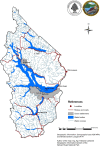Variation of local zoological knowledge about Southern river otter and other semi-aquatic mammals in Nahuel Huapi National Park (Argentina)
- PMID: 37161447
- PMCID: PMC10170775
- DOI: 10.1186/s13002-023-00590-8
Variation of local zoological knowledge about Southern river otter and other semi-aquatic mammals in Nahuel Huapi National Park (Argentina)
Abstract
Background: The huillín (Lontra provocax, Thomas 1908) is an otter, endemic to southern Argentina and Chile. It is in danger of extinction. In the Nahuel Huapi National Park and surroundings is the only freshwater, known and stable population of huillín in Argentina. In this park, several urban and rural centers coexist with this species. The main objective of our work was to answer: How does the local zoological knowledge (LZK) vary about the huillín, particularly its identification and sighting, among people from different social groups, with different ages and gender, who live in the rural or urban environment and with different periods of permanence in the place?
Methods: Ninety-six written interviews were conducted using visual stimuli to ensure that interviewees refer to the huillín. In addition, we also inquire about the LZK of other species with which it can be confused. Additional open interviews were conducted with participants who observed the huillín to determine the georeferencing of the reported sites and include them on a final map.
Results: 95% of people identified the huillín and this was confused with the coipo in 3% and with the american mink, in 5%. The results show that, in general, the LZK did not vary significantly with the sociocultural characteristics of the participants, showing a remarkable homogeneity. However, people in rural areas are more likely to observe the species than people in urban areas. Moreover, people between 20 and 40 years of age are more likely to observe the huillín. The LZK mapping has identified areas that are consistent with and/or adjacent to official source records. Other areas have also been identified that may provide new information.
Conclusion: With this participatory work, we realize that the species is recognized by urban and rural inhabitants and very few confused it. The homogeneity in the LZK found constitutes a kick for the realization of other participatory studies that promote lines of research, action and management that improve the quality of the environments where the only freshwater, known and stable population of the huillín in Argentina lives.
Keywords: Citizen science; Ethnozoology; Otter; Participatory workshops.
© 2023. The Author(s).
Conflict of interest statement
The authors have no conflicts of interest to declare.
Figures



References
-
- Valenzuela A, Fasola L, Pozzi C, Chehébar C, Ferreyra N, Gallo E, Massaccessi, G. Lontra provocax. En: SAyDS–SAREM (eds.) Categorización 2019 de los mamíferos de Argentina según su riesgo de extinción. Lista Roja de los mamíferos de Argentina. Versión digital: http://cma.sarem.org.ar. Consultado el 9 de enero de 2023.
-
- Sepúlveda M, Valenzuela A, Pozzi C, Medina-Vogel G, Chehébar C. Lontra provocax. The IUCN Red List of Threatened Species 2015. Consultado el 9 de enero de 2023.
-
- Kruuk H. Otters: ecology behaviour and conservation. Oxford University Press; 2006. p. 265.
-
- Chehébar C, Ramilo E. Fauna del Parque Nacional Nahuel Huapi. Administración de Parques Nacionales, Argentina. 1992.
-
- Foster-Turley P. Introduction and overall recommendation. In: P. Foster-Turley, S. Macdonald y C. Mason (eds.), Otters: An action plan for their conservation. IUCN/SSC Otter Specialist Group, IUCN. Kelvin Press, Inc., Illinois;1990.
MeSH terms
Grants and funding
LinkOut - more resources
Full Text Sources

